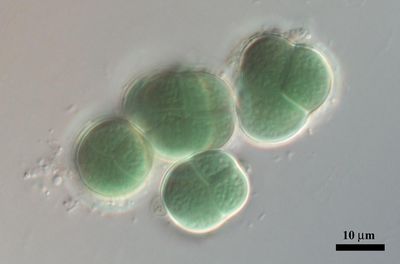Chroococcidiopsis: Difference between revisions
No edit summary |
|||
| Line 21: | Line 21: | ||
==Genome Structure== | ==Genome Structure== | ||
''Chroococcidiopsis thermails'' genome is one chromosome contains 6.69 megabase pairs (Mbp) made up of 6,033 genes and containing 5,752 encoding proteins. [6] The genome has a G+C makeup of 44.4%. [6] ''Chroococcidiopsis'' was traditionally assigned under the order Pleurocapsales due to baeocyte formation, but only after phylogenetic studies on 16S rRNA sequence they found that their closest living relative is the heterocyte forming cyanobacteria. [7] ''Chroococcidiopsis'' sp. TS-821 differ from other cyanobacteria by forming tetrameric or dimeric Photosystem I reactions centers rather than the usual trimmeric complexes most cyanobacteria have [1]. Analysis comparing ''Chroococcidiopsis'' PsaL protein sequences to Heterocyst-forming cyanobacteria reiterated their close relationship since heterocyst-forming cyanobacteria also form tetrameric | ''Chroococcidiopsis thermails'' genome is one chromosome contains 6.69 megabase pairs (Mbp) made up of 6,033 genes and containing 5,752 encoding proteins. [6] The genome has a G+C makeup of 44.4%. [6] ''Chroococcidiopsis'' was traditionally assigned under the order Pleurocapsales due to baeocyte formation, but only after phylogenetic studies on 16S rRNA sequence they found that their closest living relative is the heterocyte forming cyanobacteria. [7] ''Chroococcidiopsis'' sp. TS-821 differ from other cyanobacteria by forming tetrameric or dimeric Photosystem I reactions centers rather than the usual trimmeric complexes most cyanobacteria have [1]. Analysis comparing ''Chroococcidiopsis'' PsaL protein sequences to Heterocyst-forming cyanobacteria reiterated their close relationship since heterocyst-forming cyanobacteria also form tetrameric centers of PSI [1]. | ||
==Cell Structure, Metabolism and Life Cycle== | ==Cell Structure, Metabolism and Life Cycle== | ||
Revision as of 19:17, 28 April 2014

Classification
Bacteria; Cyanobacteria; Cyanophyceae; Chroococcales; Xenococcaceae NCBI link to find]
Species
|
NCBI: Taxonomy |
Chroococcidiopsis thermalis, Chroococcidiopsis gigantea, Chroococcidiopsis cubana, Chroococcidiopsis codiicola
Description and Significance
Chroococcidiopsis is a primitive, unicellular cyanobacteria. It can survive in a diverse array of harsh conditions. They can survive under extreme temperatures or pHs, high levels of radiation, high concentrations of salt, and arid environments. [5] It is an important microorganism to study due to their ability to survive in these extreme conditions. They release neurotoxins as a by product of their metabolism that can contaminated drinking water.
Genome Structure
Chroococcidiopsis thermails genome is one chromosome contains 6.69 megabase pairs (Mbp) made up of 6,033 genes and containing 5,752 encoding proteins. [6] The genome has a G+C makeup of 44.4%. [6] Chroococcidiopsis was traditionally assigned under the order Pleurocapsales due to baeocyte formation, but only after phylogenetic studies on 16S rRNA sequence they found that their closest living relative is the heterocyte forming cyanobacteria. [7] Chroococcidiopsis sp. TS-821 differ from other cyanobacteria by forming tetrameric or dimeric Photosystem I reactions centers rather than the usual trimmeric complexes most cyanobacteria have [1]. Analysis comparing Chroococcidiopsis PsaL protein sequences to Heterocyst-forming cyanobacteria reiterated their close relationship since heterocyst-forming cyanobacteria also form tetrameric centers of PSI [1].
Cell Structure, Metabolism and Life Cycle
Chroococcidiopsis is a negative gram, spherical cyanobacteria. It is prokaryotic meaning it lacks a nucleus. Chroococcidiopsis performs oxygenic photosynthesis. It is nitrogen fixing producing ammonia, nitrites, or nitrates. Heterocysts are commonly formed in low concentrations of nitrogen. The average cell has a diameter of 2-6 μm and is surround by thin, colorless, extracellular polysaccharide sheathes.They have a high desiccation tolerance due to the EPS that surround them.Thylakoid distributions are irregular throughout the cell. They are rarely found solitary, usually living in less spherical colonies. Cells are sometimes gathered in free-living agglomerations. Cell division occurs in two possible ways. The first being successive binary division in different planes or by irregular cell division by multiple fissions (Geitler).
Ecology and Pathogenesis
Due to its primitive nature, it is thought that Chroococcidiopsis was a major contributor to transforming our early atmosphere by releasing oxygen as a byproduct that accumulated creating an oxidizing environment. Another implication of Chroococcidiopsis is its ability to produce neurotoxic by products such as β-N-methylamino-L-alanine that can create a health hazard for drinking water, particularly in underdeveloped countries. This can lead to malfunctioning of the nervous system and in severe cases death. Chroococcidiopsis is currently thought to be one of the only microbes that would be capable of surviving in Mars' extreme environmental conditions. The possibility of farming Chroococcidiopsis to produce organic material to create soil and add oxygen to its atmosphere may one day be able to create conditions suitable for farming and life on Mars.
References
[1] Meng, L., Semchonok, D., Boekema. ““Characterization and Evolution of Tetrameric Photosystem I from the Thermophilic Cyanobacterium Chroococcidiopsis sp TS-821”. “The Plant Cell”. March 2014.]
[2] Billi, D., Friedmann, E., Helm, R., Potts, M. “”Gene Transfer to the Desiccation-Tolerant Cyanobacterium Chroococcidiopsis”. “Journal of Bacteriology”. 2001. Volume 183. p. 2298-2305.]
[3] NASA. “Greening of the Red Planet”. “National Aeronautics and Space Administration.” January 2001.]
[4] Geitler, L. “Chroococcopsis.”]
[5] Magana-Arachchi, M. Wanigatunge, R.P. “First report of genus Chroococcidiopsis (cyanobacteria) from Sri Lanka: a potential threat to human health”. Journal of the National Science Foundation”. 2013. Volume 41. P. 65-68.]
[6] ”Chroococcidiopsis thermalis.”]
[7] Fewer, D., Friedl, T., Budel, B. "Chroococcidiopsis and heteroyst-differentiating cyanobacteria are each other's closest living relatives". Molecular Phylogenetic Evolution." 2002. Volume 23. p. 82-90.]
Author
Page authored by Lauren Pifer, student of Prof. Jay Lennon at IndianaUniversity.
